Structural Insights into the Activation of Human Relaxin Family Peptide Receptor 1 by Small-Molecule Agonists
- PMID: 26866459
- PMCID: PMC5137375
- DOI: 10.1021/acs.biochem.5b01195
Structural Insights into the Activation of Human Relaxin Family Peptide Receptor 1 by Small-Molecule Agonists
Abstract
The GPCR relaxin family peptide receptor 1 (RXFP1) mediates the action of relaxin peptide hormone, including its tissue remodeling and antifibrotic effects. The peptide has a short half-life in plasma, limiting its therapeutic utility. However, small-molecule agonists of human RXFP1 can overcome this limitation and may provide a useful therapeutic approach, especially for chronic diseases such as heart failure and fibrosis. The first small-molecule agonists of RXFP1 were recently identified from a high-throughput screening, using a homogeneous cell-based cAMP assay. Optimization of the hit compounds resulted in a series of highly potent and RXFP1 selective agonists with low cytotoxicity, and excellent in vitro ADME and pharmacokinetic properties. Here, we undertook extensive site-directed mutagenesis studies in combination with computational modeling analysis to probe the molecular basis of the small-molecule binding to RXFP1. The results showed that the agonists bind to an allosteric site of RXFP1 in a manner that closely interacts with the seventh transmembrane domain (TM7) and the third extracellular loop (ECL3). Several residues were determined to play an important role in the agonist binding and receptor activation, including a hydrophobic region at TM7 consisting of W664, F668, and L670. The G659/T660 motif within ECL3 is crucial to the observed species selectivity of the agonists for RXFP1. The receptor binding and activation effects by the small molecule ML290 were compared with the cognate ligand, relaxin, providing valuable insights on the structural basis and molecular mechanism of receptor activation and selectivity for RXFP1.
Conflict of interest statement
The authors declare no competing financial interest.
Figures
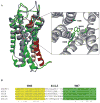
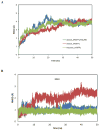

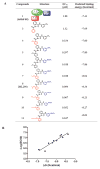

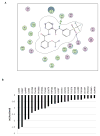
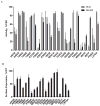



Similar articles
-
Synthetic non-peptide low molecular weight agonists of the relaxin receptor 1.Br J Pharmacol. 2017 May;174(10):977-989. doi: 10.1111/bph.13656. Epub 2016 Nov 30. Br J Pharmacol. 2017. PMID: 27771940 Free PMC article. Review.
-
Investigation of interactions at the extracellular loops of the relaxin family peptide receptor 1 (RXFP1).J Biol Chem. 2014 Dec 12;289(50):34938-52. doi: 10.1074/jbc.M114.600882. Epub 2014 Oct 28. J Biol Chem. 2014. PMID: 25352603 Free PMC article.
-
The different ligand-binding modes of relaxin family peptide receptors RXFP1 and RXFP2.Mol Endocrinol. 2012 Nov;26(11):1896-906. doi: 10.1210/me.2012-1188. Epub 2012 Sep 12. Mol Endocrinol. 2012. PMID: 22973049 Free PMC article.
-
Identification of small-molecule agonists of human relaxin family receptor 1 (RXFP1) by using a homogenous cell-based cAMP assay.J Biomol Screen. 2013 Jul;18(6):670-7. doi: 10.1177/1087057112469406. Epub 2012 Dec 4. J Biomol Screen. 2013. PMID: 23212924 Free PMC article.
-
Relaxin family peptide receptors--former orphans reunite with their parent ligands to activate multiple signalling pathways.Br J Pharmacol. 2007 Mar;150(6):677-91. doi: 10.1038/sj.bjp.0707140. Epub 2007 Feb 12. Br J Pharmacol. 2007. PMID: 17293890 Free PMC article. Review.
Cited by
-
Synthetic non-peptide low molecular weight agonists of the relaxin receptor 1.Br J Pharmacol. 2017 May;174(10):977-989. doi: 10.1111/bph.13656. Epub 2016 Nov 30. Br J Pharmacol. 2017. PMID: 27771940 Free PMC article. Review.
-
The relaxin receptor RXFP1 signals through a mechanism of autoinhibition.Nat Chem Biol. 2023 Aug;19(8):1013-1021. doi: 10.1038/s41589-023-01321-6. Epub 2023 Apr 20. Nat Chem Biol. 2023. PMID: 37081311 Free PMC article.
-
Optimization of the first small-molecule relaxin/insulin-like family peptide receptor (RXFP1) agonists: Activation results in an antifibrotic gene expression profile.Eur J Med Chem. 2018 Aug 5;156:79-92. doi: 10.1016/j.ejmech.2018.06.008. Epub 2018 Jun 7. Eur J Med Chem. 2018. PMID: 30006176 Free PMC article.
-
Discovery of small molecule agonists of the Relaxin Family Peptide Receptor 2.Commun Biol. 2022 Nov 4;5(1):1183. doi: 10.1038/s42003-022-04143-9. Commun Biol. 2022. PMID: 36333465 Free PMC article.
-
Relaxin-like peptides in male reproduction - a human perspective.Br J Pharmacol. 2017 May;174(10):990-1001. doi: 10.1111/bph.13689. Epub 2017 Feb 27. Br J Pharmacol. 2017. PMID: 27933606 Free PMC article. Review.
References
-
- Bathgate RA, Halls ML, van der Westhuizen ET, Callander GE, Kocan M, Summers RJ. Relaxin family peptides and their receptors. Physiol Rev. 2013;93:405–480. - PubMed
-
- Bogatcheva NV, Truong A, Feng S, Engel W, Adham IM, Agoulnik AI. GREAT/LGR8 is the only receptor for insulin-like 3 peptide. Mol Endocrinol. 2003;17:2639–2646. - PubMed
-
- Halls ML, Bond CP, Sudo S, Kumagai J, Ferraro T, Layfield S, Bathgate RA, Summers RJ. Multiple binding sites revealed by interaction of relaxin family peptides with native and chimeric relaxin family peptide receptors 1 and 2 (LGR7 and LGR8) J Pharmacol Exp Ther. 2005;313:677–687. - PubMed
-
- Kong RC, Shilling PJ, Lobb DK, Gooley PR, Bathgate RA. Membrane receptors: structure and function of the relaxin family peptide receptors. Mol Cell Endocrinol. 2010;320:1–15. - PubMed
Publication types
MeSH terms
Substances
Grants and funding
LinkOut - more resources
Full Text Sources
Other Literature Sources

